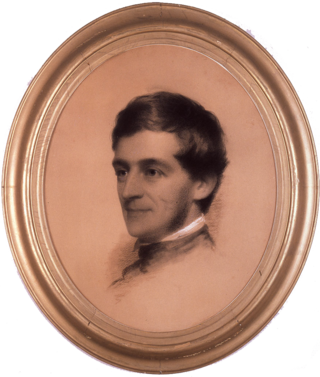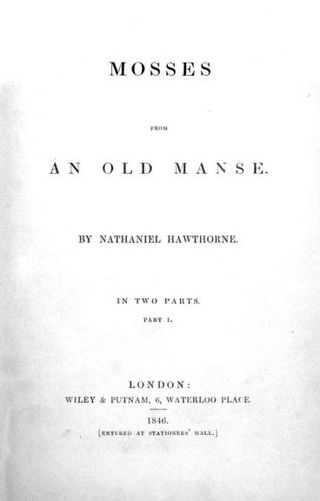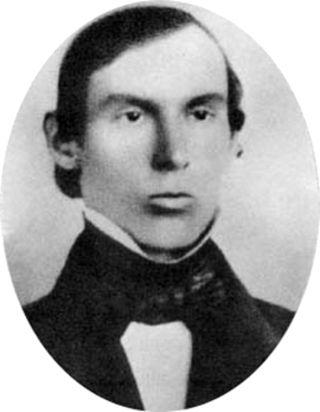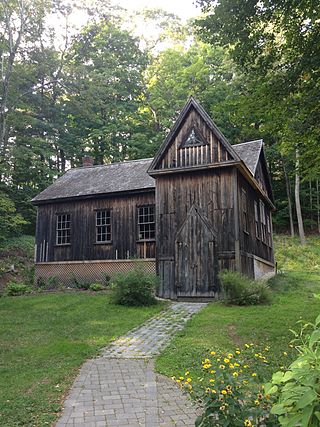
Ralph Waldo Emerson, who went by his middle name Waldo, was an American essayist, lecturer, philosopher, abolitionist and poet who led the transcendentalist movement of the mid-19th century. He was seen as a champion of individualism and critical thinking, as well as a prescient critic of the countervailing pressures of society and conformity. Friedrich Nietzsche considered him "the most gifted of the Americans", and Walt Whitman referred to him as his "master".
Transcendentalism is a philosophical, spiritual, and literary movement that developed in the late 1820s and 1830s in the New England region of the United States. A core belief is in the inherent goodness of people and nature, and while society and its institutions have corrupted the purity of the individual, people are at their best when truly "self-reliant" and independent. Transcendentalists saw divine experience inherent in the everyday, rather than believing in a distant heaven. Transcendentalists saw physical and spiritual phenomena as part of dynamic processes rather than discrete entities.

"Self-Reliance" is an 1841 essay written by American transcendentalist philosopher Ralph Waldo Emerson. It contains the most thorough statement of one of his recurrent themes: the need for each person to avoid conformity and false consistency, and follow his or her own instincts and ideas. It is the source of one of his most famous quotations:

Sleepy Hollow Cemetery is a rural cemetery located on Bedford Street near the center of Concord, Massachusetts. The cemetery is the burial site of a number of famous Concordians, including some of the United States' greatest authors and thinkers, especially on a hill known as "Author's Ridge."
The Transcendental Club was a group of New England authors, philosophers, socialists, politicians and intellectuals of the early-to-mid-19th century which gave rise to Transcendentalism.

Christopher Pearse Cranch was an American writer and artist.

Mosses from an Old Manse is a short story collection by Nathaniel Hawthorne, first published in 1846.

James Freeman Clarke was an American minister, theologian and author.

Frederic Henry Hedge was a New England Unitarian minister and Transcendentalist. He was a founder of the Transcendental Club, originally called Hedge's Club, and active in the development of Transcendentalism, although he distanced himself from the movement as it advanced.

The North Bridge, often colloquially called the Old North Bridge, is a historic site in Concord, Massachusetts, spanning the Concord River. On April 19, 1775, the first day of the American Revolutionary War, provincial minutemen and militia companies numbering approximately 400 engaged roughly 90 British Army troops at this location. The battle was the first instance in which American forces advanced in formation on the British regulars, inflicted casualties, and routed their opponents. It was a pivotal moment in the Battles of Lexington and Concord and in American history. The significance of the historic events at the North Bridge inspired Ralph Waldo Emerson to refer to the moment as the "shot heard round the world."

The Old Manse is a historic manse in Concord, Massachusetts, United States, notable for its literary associations. It is open to the public as a nonprofit museum owned and operated by the Trustees of Reservations. The house is located on Monument Street, with the Concord River just behind it. The property neighbors the North Bridge, a part of Minute Man National Historical Park.

Jones Very was an American poet, essayist, clergyman, and mystic associated with the American Transcendentalism movement. He was known as a scholar of William Shakespeare, and many of his poems were Shakespearean sonnets. He was well-known and respected among the Transcendentalists.

The Concord School of Philosophy was a lyceum-like series of summer lectures and discussions of philosophy in Concord, Massachusetts, from 1879 to 1888.

The Ralph Waldo Emerson House is a house museum located at 18 Cambridge Turnpike, Concord, Massachusetts, and a National Historic Landmark for its associations with American philosopher Ralph Waldo Emerson. He and his family named the home Bush. The museum is open mid-April to mid-October; an admission fee is charged.
"Brahma" is a poem by Ralph Waldo Emerson, written in 1856. However, the poem was published in the November 1857 issue of The Atlantic. It is named for Brahman, the universal principle of the Vedas.

"The Rhodora, On Being Asked, Whence Is the Flower", or simply "The Rhodora", is an 1834 poem by American writer Ralph Waldo Emerson, a 19th century philosopher. The poem is about the rhodora, a common flowering shrub, and the beauty of this shrub in its natural setting.

The "shot heard round the world" is a phrase that refers to the opening shot of the battles of Lexington and Concord on April 19, 1775, which sparked the American Revolutionary War and led to the creation of the United States. It originates from the opening stanza of Ralph Waldo Emerson's 1837 poem "Concord Hymn". The phrase has subsequently been applied to the assassination of Archduke Franz Ferdinand in 1914, a catalyst event for World War I, and hyperbolically applied to feats in sports.

Samuel Gray Ward was an American poet, author, and minor member of the Transcendentalism movement. He was also a banker and a co-founder of the Metropolitan Museum of Art. Among his circle of contemporaries were poets and writers such as Ralph Waldo Emerson and Margaret Fuller who were deeply disappointed when Ward gave up a career in writing for business just before he married.

Caroline Sturgis Tappan, commonly known as Caroline Sturgis, or "Cary" Sturgis, was an American Transcendentalist poet and artist. She is particularly known for her friendships and frequent correspondences with prominent American Transcendentalists, such as Margaret Fuller and Ralph Waldo Emerson. Sturgis published 25 poems in four different volumes of The Dial, a Transcendental periodical. She also wrote and illustrated two books for children, Rainbows for Children (1847) and The Magician’s Show Box, and Other Stories (1856).

The Minute Man is an 1874 sculpture by Daniel Chester French in Minute Man National Historical Park, Concord, Massachusetts. It was created between 1871 and 1874 after extensive research, and was originally intended to be made of stone. The medium was switched to bronze and it was cast from ten Civil War-era cannons appropriated by Congress.


















